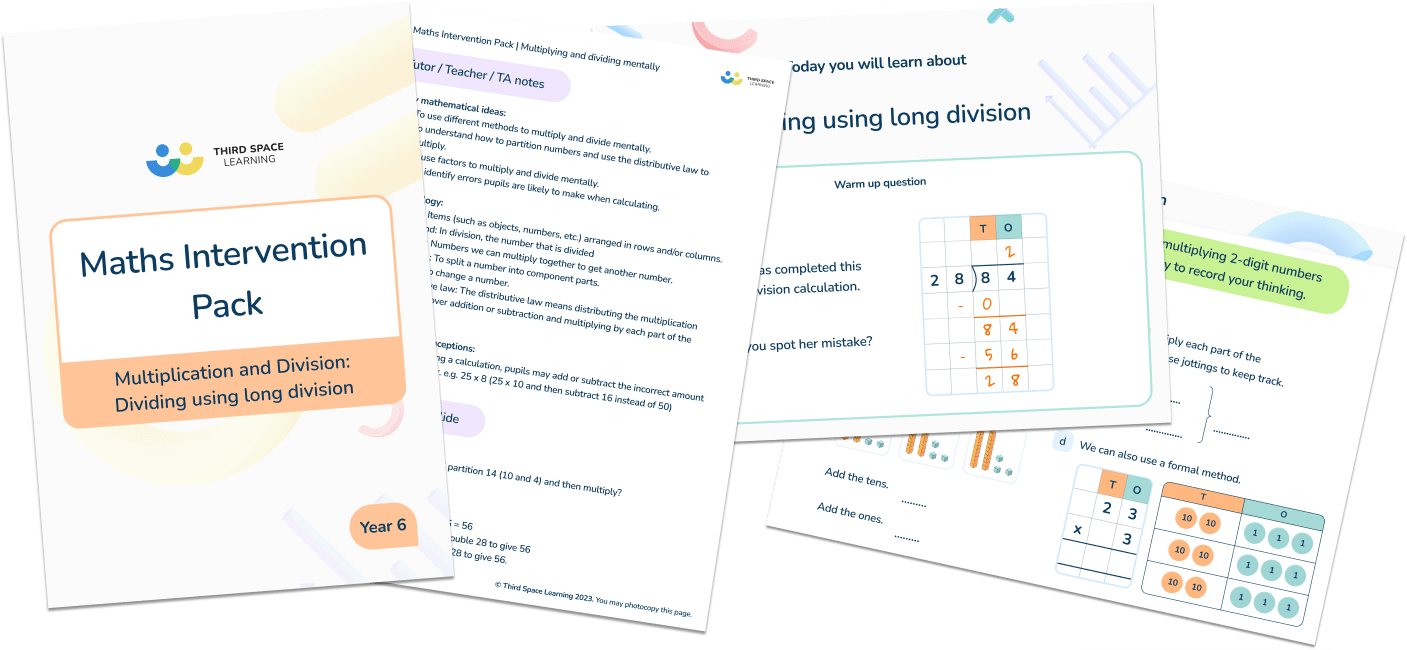What Is Division With Remainders? Explained For Primary School
Division with remainders, and division more generally, is a key skill in primary school maths. Pupils in upper Key Stage 2 will be introduced to division calculations with remainders – where there is a certain amount left over. In this article, we will explain division with remainders and provide worked examples, including word problems, to support your teaching of division with remainders to your primary school pupils.
The four operations (addition, subtraction, multiplication and division) are a key part of the maths curriculum throughout primary school. From Year 1 until Year 4, children are only taught division where the answers are exact. In upper KS2, students will need to be confident working with division problems with remainders.
- What is division with remainders?
- How to work out division with remainders
- Division with remainders examples
- When do children learn about division with remainders in school?
- How does division with remainders relate to other areas of maths?
- How does division with remainders link to real life?
- Dividing with remainders worked examples
- Dividing with remainders practice questions
What is division with remainders?
Division with remainders is a division calculation without an exact answer – the answer will have a particular amount left over.
- The first number (the amount being divided) is called the dividend;
- The second number (whatever the dividend is being divided by), is called the divisor;
- The answer is called the quotient.
In a division calculation with remainders, we therefore say the quotient will have a particular amount left over. This remainder can be expressed as a standard remainder (written as ‘r’ and then the remainder) or a fraction (the remainder becomes the numerator and the divisor becomes the denominator).
For example, with short division or the bus stop method (often used when the divisor is a 1-digit number), 432 ÷ 5 = 86r2 (standard remainder) and 496 ÷ 11 = 45 \frac{1}{11} (fraction remainder). The examples below are taken from the appendix in the maths national curriculum.
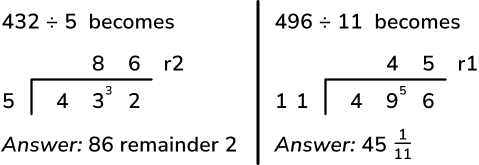
With long division (often used when the divisors are 2 digit numbers), 432 ÷ 15 can be expressed as 28r12, 28 \frac{4}{5} or 28.8, as in these national curriculum examples below.
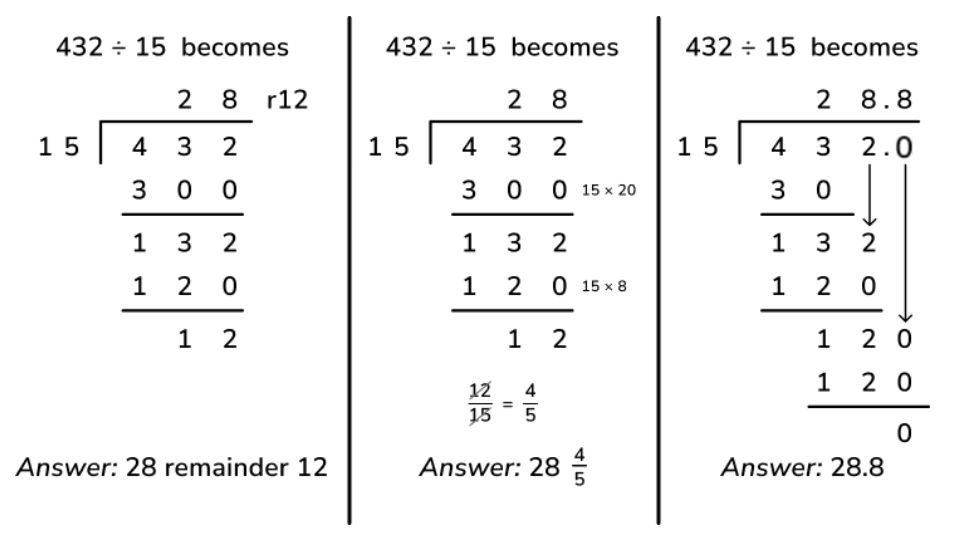
See also: What Is Division?
Maths Intervention Pack Multiplication and Division
A series of intervention lessons for pupils from Year 2 to Year 6 to help their understanding of understanding of multiplication and division.
Download Free Now!How to work out division with remainders
In a division with remainders, the remainder will always be smaller than the divisor. If it is bigger, an error has been made as this means another ‘group’ could be made out of that remainder.
For example, take 14 ÷ 3. There are 4 groups of 3 in 14 with 2 left over – this is expressed as 4r2. Technically, as in the second example below, this could also be written as 3r5, however we can make another group of the divisor (3) out of the remainder (5), which would then turn it into 4r2 as the original answer.
Likewise, this could also technically be written as 2r8 (although we could make 2 more groups of the divisor from the remainder here) or 1r11 (we could make 3 more groups of the divisor from this remainder), but the original answer of 4r2 is the mathematically correct one.
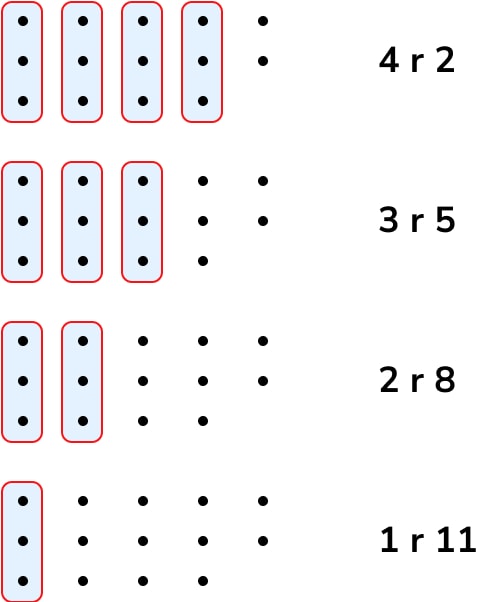
This concept is the same with both the short and long division methods. Remember that the remainder can be expressed in one of three ways.
- As a remainder (e.g. r1 in the example below)
- As a fraction (e.g. \frac{1}{5} in the example below – the remainder of 1 becomes the numerator of the fraction and the divisor, 5, becomes the denominator).

- As a decimal

The method is the same as above but once the division of the ones digit has been completed, add a decimal point and a zero to the end of the dividend to essentially ‘continue’ the division (continue to ensure the place value digits are aligned correctly).
In this case, after calculating that 21 ones divided by 5 is 4 ones with 1 remaining, the 1 remaining ones can be seen as 10 tenths instead. We can then divide 10 tenths by 5, which is 2 tenths, hence the quotient being 134.2.
This is the same as 134r1 or 134 \frac{1}{5} as, when dividing by 5, a remainder of 1 is the same as \frac{1}{5} , which is equivalent to 2 tenths.
If the decimal remainder is longer than one decimal place, continue to add 0s to the dividend until the division is complete or if the decimals continue for a long time, as in the example below of 425 ÷ 7, just round up to the required degree of accuracy – in this case, 60.7 to 1 decimal place (or 60.7143 to 3 decimal places).

Division problems with a remainder longer than 2 decimal places are unlikely to be asked of children in primary school. However, it is useful to know how to interpret these answers – especially how to round decimal places – as divisions completed on calculators might give answers with many decimal places and children will need to understand what this means.
This process is the same for when you do the long division method. For example, 9,139 ÷ 21 can be expressed as 435r4, 435 \frac{4}{21} or 435.19 (rounded to 2 decimal places).

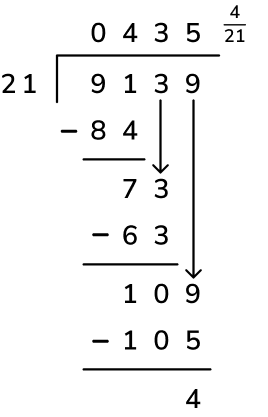

Division with remainders examples
See examples below of short division with remainders expressed in all three ways.

The 3rd example of the four-digit division below is an example of a recurring decimal remainder – in this case, the digit 3 would continue on forever, so it is better to express this remainder as a fraction ( \frac{1}{3} in this case).

The remainder of these long division problems can also be expressed in three different ways (the method is the same even with large numbers as divisors).
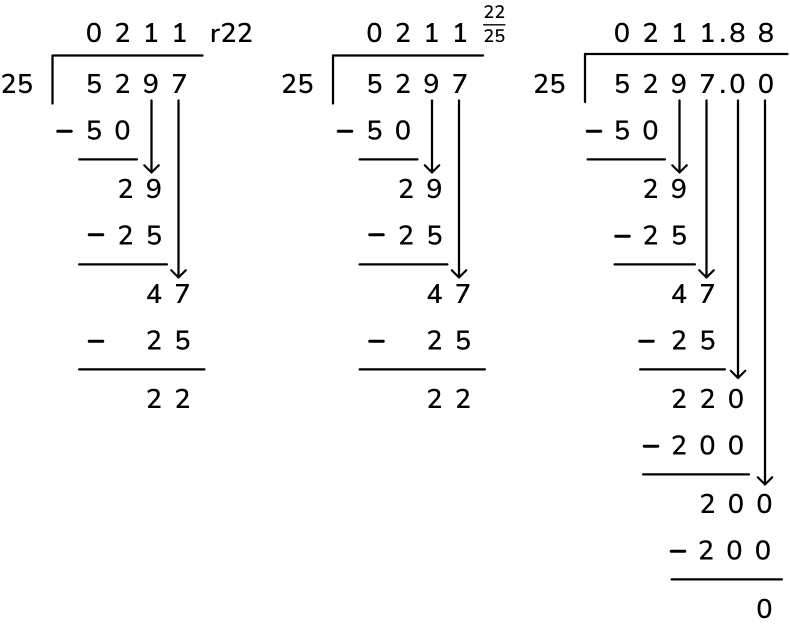
When do children learn about division with remainders in school?
The national curriculum states that Year 5 pupils should be taught to divide numbers up to 4 digits by a one-digit number using the formal written method of short division and interpret remainders appropriately for the context.
Year 5 pupils could also (non-statutory guidance) connect equivalent fractions > 1 that simplify to integers with division and other fractions > 1 to division with remainders, using the number line and other models, and hence move from these to improper and mixed fractions.
Year 6 pupils should be taught to divide numbers up to 4 digits by a two-digit whole number using the formal written method of long and short division, and interpret remainders as whole number remainders, fractions, or by rounding, as appropriate for the context.
Learn more about how to teach division in our article.
How does division with remainders relate to other areas of maths?
In Year 6, as children are required to calculate decimal fraction equivalents for a simple fraction, they may need to complete a division with a decimal remainder. For example, to work out the decimal equivalent of \frac{5}{8} , children would need to divide 5 by 8, which can be made into 5.000 ÷ 8 in this case as the answer (0.625) has 3 decimal places.
How does division with remainders link to real life?
Whenever something needs to be shared between two or more groups, division is required, with or without remainders. The suitable ‘type’ of remainder depends on the context of the problem.
‘Standard’ or fraction remainders would be appropriate in contexts where an exact answer is not necessarily required. For example, 267 people need transporting on a coach trip and coaches hold 42 people. 267 ÷ 42 = 6r15, or 6 \frac{15}{42} , or 6.36 (rounded to 2dp). We can’t have part of a coach, so we would need 7 coaches here (rounding up to the nearest whole number). The decimal remainder would be trickier to interpret (what is 0.36 of a coach?) but the other remainders tell us that there would be 15 people left for the 7th coach whilst the others would be full.
Decimal remainders would be more appropriate in contexts such as money. For example, a £188 bill split between five people is 188 ÷ 5 which is 37r3, or 37 \frac{3}{5} , or 37.6. The decimal remainder here lends itself to a monetary context – in this case, each person would owe £37.60.
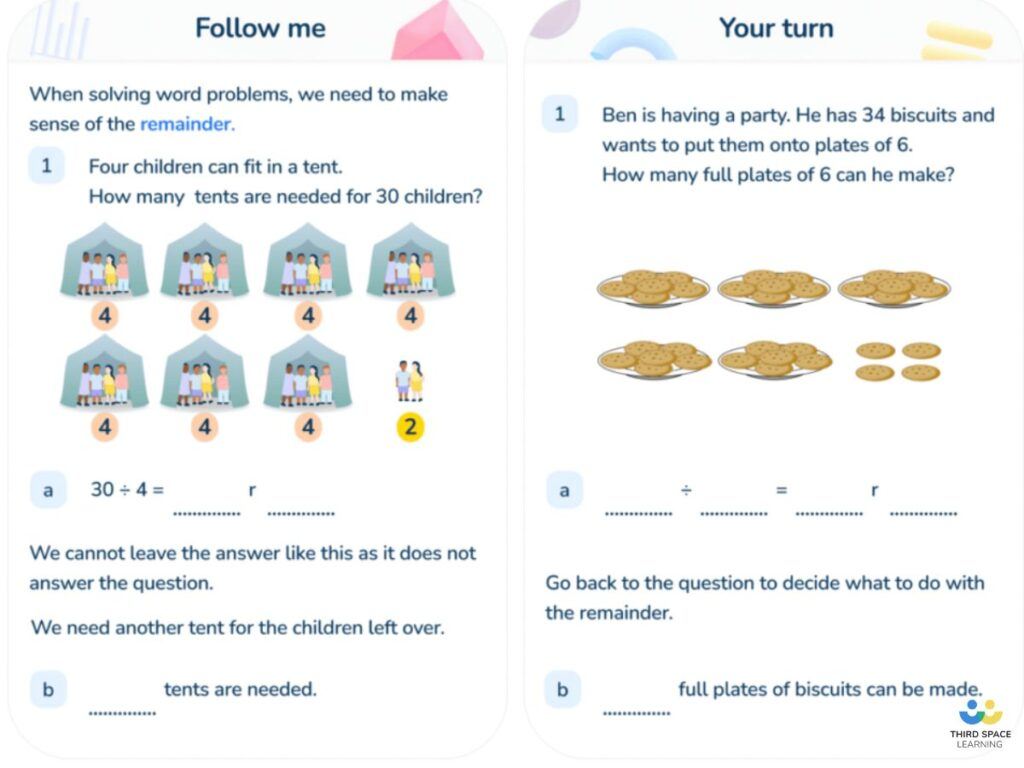
Dividing with remainders worked examples
1. 96 pupils and teachers go by minibus to the sports tournament. How many 15-seater minibuses will be required?
96 ÷ 15 = 6r6 (this could be done with a written division method but in this case it is easier to count in 15s to see how many fit into 96 – 15, 30, 45, 60, 75, 90 = 6 groups). There is a remainder of 6 which means 6 people are left without a coach, so 7 minibuses would be required.
2. Complete the number sentences:
a) 340 ÷ 7 = ___ remainder ___
b) ___ ÷ 3 = 295 remainder 2
a) Use short division to get the answer 48 remainder 4

b) As the dividend here is missing, we need to use the inverse to work it out. Imagine the question was __ ÷ 2 = 3 remainder 1. We can work out the dividend by multiplying the divisor by the quotient and adding the remainder: 3 x 2 + 1 = 7, so 7 ÷ 2 = 3 remainder 1. The same method applies here – multiply the divisor (3) by the quotient (295) and add the remainder (2) – this gives us 887, so the answer is 887 ÷ 3 = 295 remainder 2.
3. A grocer is packing eggs. Each box holds 6 eggs. The grocer has 980 eggs to pack. How many boxes can she fill and how many eggs will be left over?
Using short division, we can work out that the grocer can fill 163 boxes and there will be 2 eggs left over.

Dividing with remainders practice questions
- There are 275 children in Blockley School. They get into groups of eight. What is the largest number of groups of eight that they can make?
Answer: 34 groups - Which two divisions have an answer of 5r2?
a) 17 ÷ 5
b) 17 ÷ 3
c) 22 ÷ 4
d) 22 ÷ 5
Answers: b) and c) - Martha wants to buy a toy which costs £18.49. She saves £1.50 per week. How many weeks does she have to save for before she can buy the book?
Answer: 13 weeks - Write the missing number in each calculation:
a) 25 ÷___ = 3r4
b) 35 ÷ ___ = 4r3
Answers: a) 7; b) 8 - A bag has 90 marbles in it. 4 children take 20 marbles each. How many marbles are left in the bag?
Answer: 10 marbles
Looking for more resources for teaching division? Why not check out our articles all about division questions and our division worksheets.
Read more:
- How To Teach Division KS2: Maths Bootcamp [7]
- Partitioning Explained For Primary School Parents And Kids
- What We’ve Learnt From Teaching Our Long Division Lesson 2,968 Times
Share the full amount into equal groups, as you would complete a normal division. Whatever is left over (and doesn’t fit into an equal group) is the remainder.
Remainders are the ‘leftovers’ in a division – when a number has been divided and the answer is not an exact number. These can be expressed as a number, a fraction or a decimal.
DO YOU HAVE STUDENTS WHO NEED MORE SUPPORT IN MATHS?
Every week Third Space Learning’s maths specialist tutors support thousands of students across hundreds of schools with weekly online maths tuition designed to plug gaps and boost progress.
Since 2013 these personalised one to one lessons have helped over 150,000 primary and secondary students become more confident, able mathematicians.
Learn about the scaffolded lesson content or request a personalised quote for your school to speak to us about your school’s needs and how we can help.

